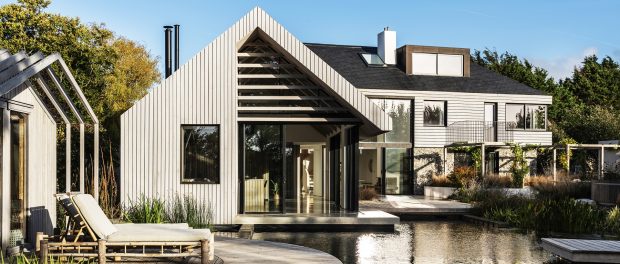Material innovation for greener buildings

Solar panel on a red roof
The future of our planet – and what we can do to protect it – is undoubtedly one of the most pressing issues on the world stage right now. It’s no surprise, then, that the construction and architecture industries are experiencing momentous shifts in attitude when it comes to the way they think about and approach projects.
It is no longer enough to make plans to become more sustainable; more eco-aware. Like in so many other areas of our lives, real, tangible changes must be made now in order to rectify some of the damage done by one of the greatest contributors to climate-change on the planet.
According to The United Nations Environment Programme, buildings are responsible for almost half of all global energy use. They’re also responsible for 40% of greenhouse gas emissions, consume 25% of all drinkable water, and create 20% of all solid waste produced in developed countries.
It’s no wonder that architects are responding with high levels of innovation when it comes to design strategies that put the future of the planet at the fore. Add to this that the green building-materials market is expected to reach over $254 billion in 2020, and it’s clear that real progress has already been made towards turning this industry on its head.
But what does all this mean in real terms? What are buildings going to look like in the not-so-distant future? And what impact will this really have on our environment?

New materials to take centre stage
Innovative new materials and construction techniques are set to take centre-stage over the coming years. Take, for example, smart glass, which can tint itself to shade interiors and prevent heat from transferring from outdoors. This futuristic new material comes in two different forms – electrochromic and thermochromic, which respond to electricity and heat retrospectively. While electrochromic smart-glass responds to an operator manually sending an electrical charge to a thin film printed on the glass, thermochromic smart-glass is arguably even more intelligent – responding to direct heat from the sun and shading the room with the appropriate level of tinting. Both are designed to significantly reduce the need to cool down buildings through air conditioning.
We’ll also eventually be seeing more ‘net-zero’ buildings pop up, which generate as much energy as they use over the course of a year – hence the name; these intelligent buildings can be run at net-zero extra cost. They operate by using passive systems to heat and cool their interiors, a process by which building mass – aka, large areas of stone, concrete or water – is used to naturally retain heat throughout the day, releasing it gradually in the cooler evening hours.
One recent article on the future of architecture predicts that we’ll be seeing a lot more of the material fungal mycelium, too: “Fast-growing, mouldable and entirely compostable, [it’s] a really exciting material to watch for its use in cladding, temporary structures, and insulation.” The same article highlights, though, that it’s not only new materials to look out for when it comes to sustainable construction…
Old materials to get a new lease of life
“As we return to basics, natural fibres are enjoying popularity right now (think cork, bamboo, plywood and linen) and these will continue to play a part in our homes. The fact that they can be produced ethically with a low impact on the environment makes them a solid choice, especially as they become visually more refined as a material.”
This concept of looking to traditional materials in a new light in order to find more sustainable methods of building isn’t necessarily a brand new one, however. Take cardboard, for example, which has been experimented with by architects for decades. This material is returned to again and again in the industry, due to it proving itself as a viable, eco-friendly material that can help us meet the increasing demand for flexible, temporary housing in a sustainable way.
A recent example of how we may be seeing cardboard being used much more in the imminent future comes in the form of the Dutch collective, Fiction Factory, who are known for building both furniture and entire houses out of the material. Their ‘Wikkelhouses’ are made from 24 layers of corrugated cardboard, which is glued together and then wrapped up in foil – demonstrating the kind of buildings we could see working their way into our constructed landscapes over the next decade.

Fiction Factory’s ‘Wikkelhouses’ are made from 24 layers of corrugated cardboard, which is glued together and then wrapped up in foil – demonstrating the kind of buildings we could see constructed over the next decade
Slow design to take over fast consumption
Buildings’ interiors are set to experience a great shift toward sustainability too – with a growing appreciation of more traditional crafts, and a genuine desire to put the focus back onto the provenance of furnishings and household items. Just as we are experiencing a backlash against ‘fast fashion’ and single-use plastics, we’re seeing a new intolerance of mass-produced home furnishings too – with millennials in particular looking to ensure the products they buy are ethically produced, have little negative impact on the environment, and will last long into the future.
One innovative furniture designer, Sebastian Cox, has taken a keen interest in mycelium furniture as a way of producing items for the home sustainably. The possibility-bending genius has shown how furniture can be grown using the underground root structure of mushrooms combined with timber.
He says in an article on his site that, “Each piece is created by the mycelium as it grows and binds the green wood waste together around purpose made frames to form lightweight, incredibly strong and completely compostable pieces of design.”
It’s this kind of innovation that we’re going to see cropping up more and more when it comes to ensuring our buildings are as sustainable inside as they are clearly set to be on the outside.
In a time where proactivity in protecting the planet is absolutely essential, thinking intelligently and ‘outside the box’ is vital. It’s comforting, then, to see that the worlds of architecture and construction are rising to challenge with gumption. The future may often feel uncertain, but when you consider the levels of highly creative problem-solving that are being shown in these industries, there’s no denying it also looks bright.




















